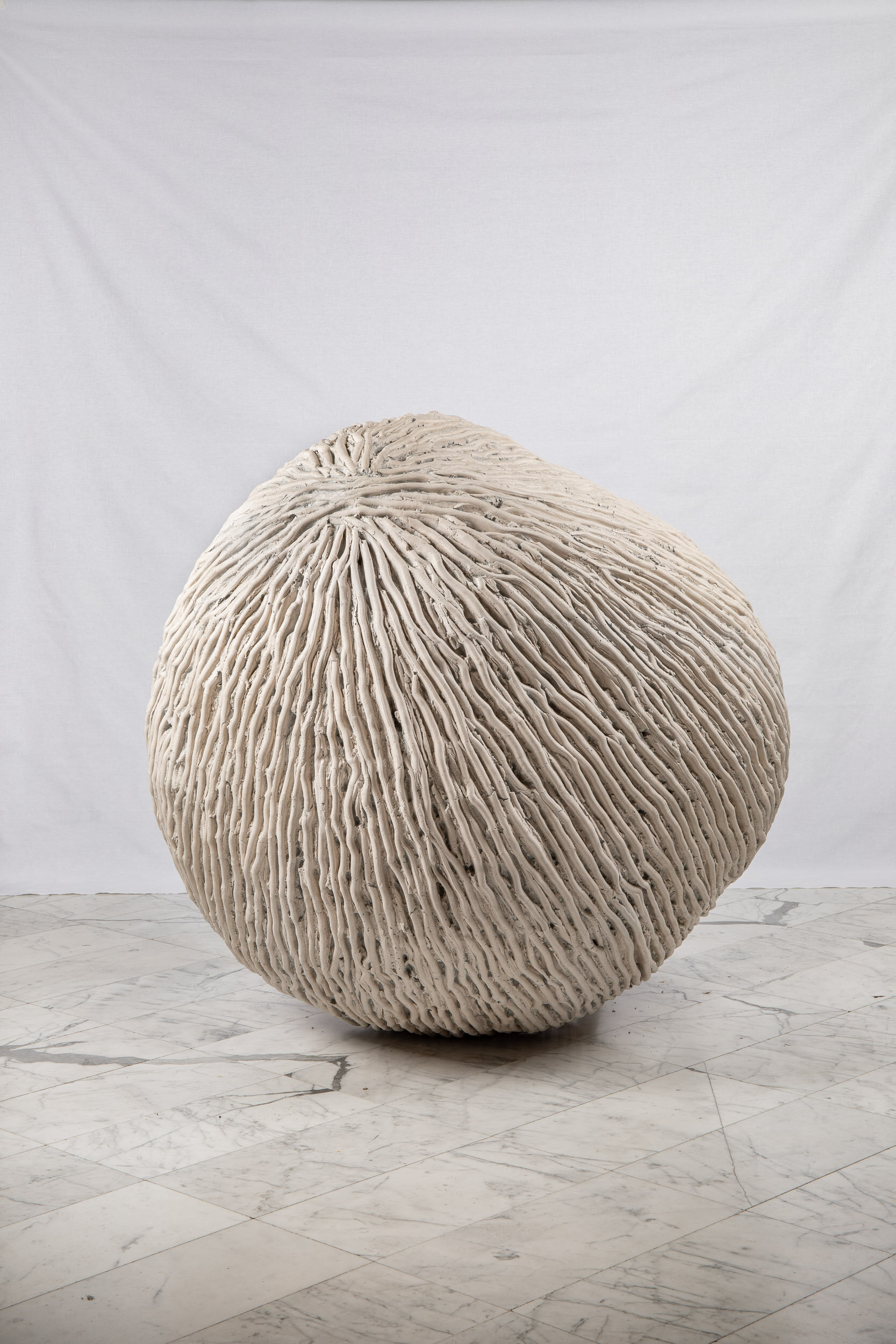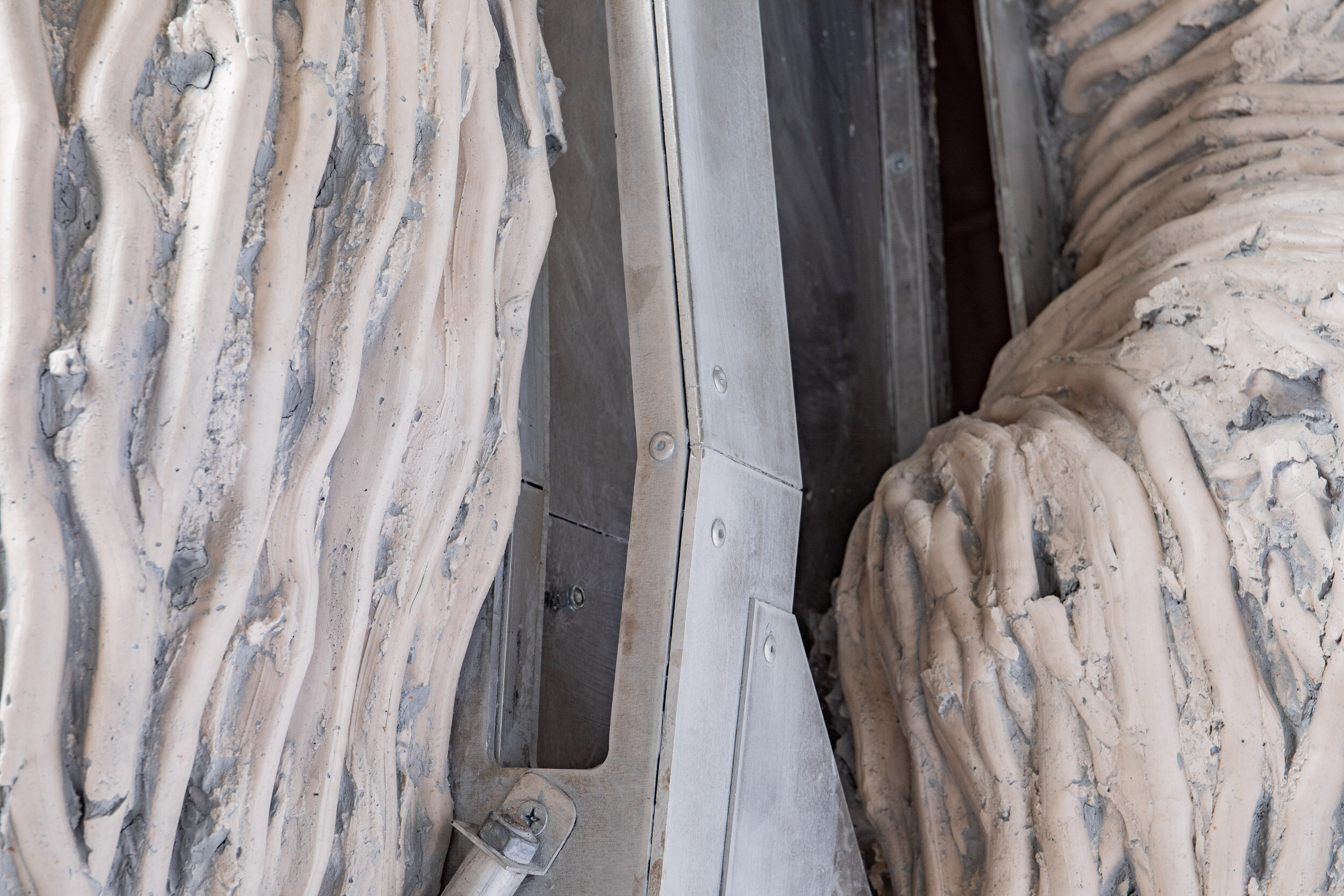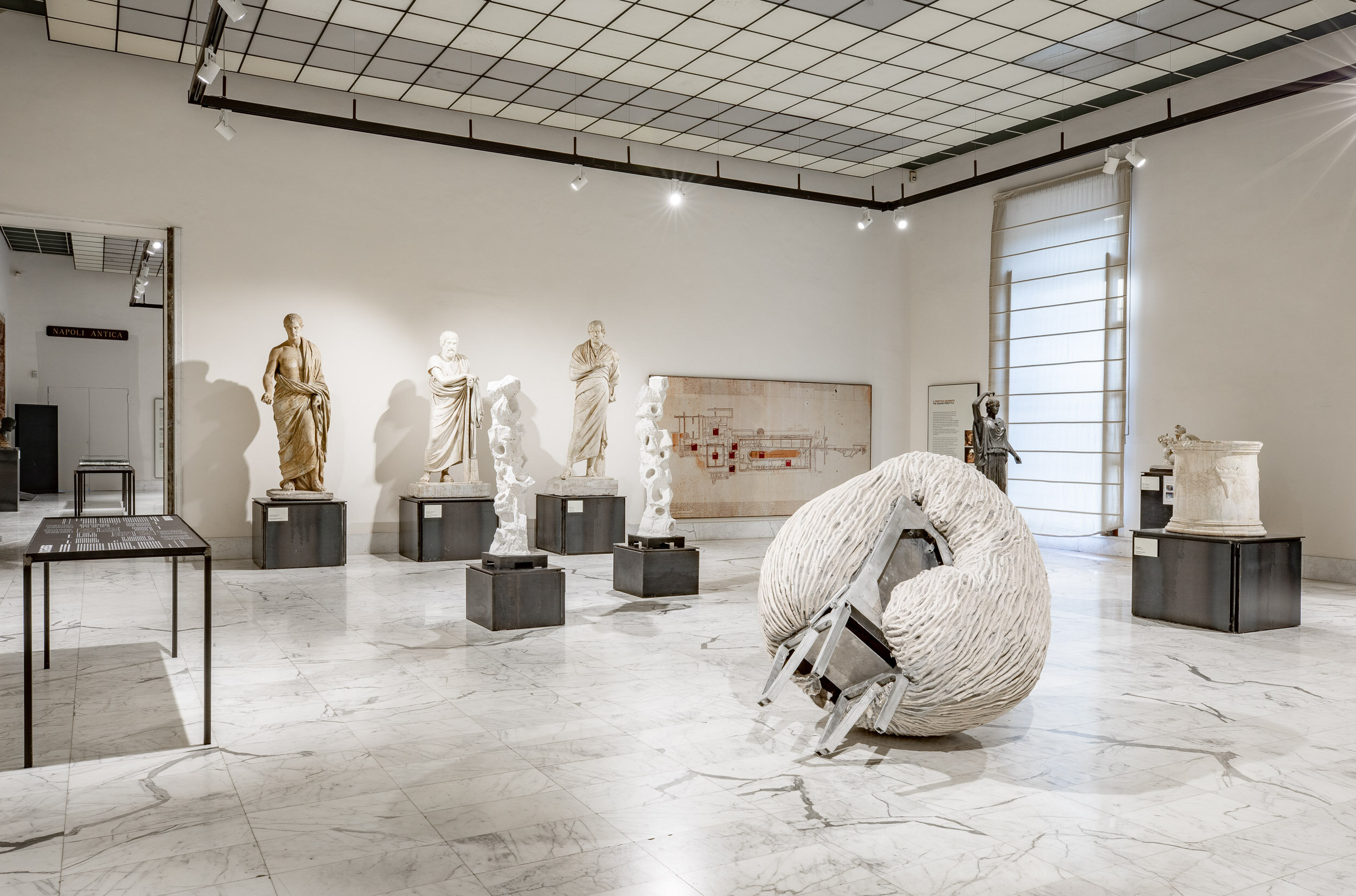ANTHROPOMETRY
2019
Anthropometry
Aquaresin, aluminium, glass fiber, steel, pigment, clay
170 x 140 x 130 cm
2019
[Image of a large gray plaster sculpture, view from the front. The volume is almost spherical , with few irregularities that make the shape look organic, almost like an egg or a stone. The surface is streaked by protruding volumetric marks, each the width of a finger, that go from the top vertex of the volume to the bottom one in an irregular pattern. The texture feels almost like an irregular weaving or the intricate surface of a coral.]
ANTHROPOMETRY
2019
In 1986 NASA published their Manned System Integration Standards handbook for the design of workstations and habitats for outer space. The research leading to this publication involved several studies measuring the human body, including a ‘grasp-reach’ study. For this sculpture Cerqueira Leite reenacted NASA’s grasp reach study within a large, clay-lined mold, while sitting on a model of NASA’s Space Shuttle chair. The resulting spherical sculpture not only demonstrates the artist’s reach, but re-defines the borders and form of her body as action.
Anthropometry
Aquaresin, aluminium, glass fiber, steel, pigment, clay
170 x 140 x 130 cm
2019
[ Image of a large gray plaster sculpture, view from the back. The volume is almost spherical , with few irregularities that make the shape feel organic, almost like an egg or a stone. A metal seat, part of a spaceship interior, is engulfed in the sculpted volume, leaning sidewise between floor and plaster mass, with its legs suspended midair. It seems as if the plaster volume grows around the piece of metal, and almost takes over it, digesting the designed geometry of the chair within its organic forms. The surface of the sculpted volume is streaked by protruding volumetric marks, each the width of a finger, that go from the top vertex of the volum to the bottom one in an irregular pattern. The texture feels almost like an irregular weaving or the intricate surface of a coral.]
Anthropometry (installation view)
Aquaresin, aluminium, glass fiber, steel, pigment, clay
170 x 140 x 130 cm
2019
[ Image of sculptures exhibited in a room of the National Archeological Museum of Naples. The floor is clad in large black and white marble tiles and the walls are white. From left to right, you have an ancient figurative metal sculpture, smaller than human size, then closer to the foreground, one of Juliana Cerqueira Leite’s sculpture, a tall plaster piece called Contraction in the foreground, further on the left and towards the back of the room, Anthropometry, described in the pictures above, and right behind it, against the back wall, an ancient stone sculpture of a female figure, larger than human size.]
Anthropometry (detail)
Aquaresin, aluminium, glass fiber, steel, pigment, clay
170 x 140 x 130 cm
2019
[ Image of a detail of Antrhropometry’s texture. The surface is streaked by protruding volumetric marks, each the width of a finger, that go from the top vertex of the volume to the bottom one in an irregular pattern. The texture feels almost like an irregular weaving or the intricate surface of a coral.]
Anthropometry (detail)
Aquaresin, aluminium, glass fiber, steel, pigment, clay
170 x 140 x 130 cm
2019
[ Image of a close up on the joint between the sculpted volume and the metal seat. The plaster volume surrounds and takes in the seat. You can notice from a slit of space between metal and plaster that the volume is empty inside and that it encloses a spherical room. One can imagine the seat and the backrest of the chair facing this space, while the sculpted surface limits its hollow volume, like a bubble. You can also notice the bottom of the seat: the way it’s constructed suggests that this part is removable. ]
Anthropometry (detail)
Aquaresin, aluminium, glass fiber, steel, pigment, clay
170 x 140 x 130 cm
2019
[ Image of a close up on the joint between the sculpted volume and the metal seat. This image focuses on the chair construction and is taken from a slight angle,, sideways. The chair is a custom made aluminum construction. The industrial material of the seat contract with the organic texture of the plaster, with the trails left by the fingers during the sculpting process in evidence. ]
Anthropometry (installation view)
Aquaresin, aluminium, glass fiber, steel, pigment, clay
170 x 140 x 130 cm
2019
[ Image of sculptures exhibited in a room of the National Archeological Museum of Naples. The floor is clad in large black and white marble tiles and the walls are white. On the right wall there’s a big window that goes from floor to ceiling. The light coming in from the outside is filtered through ivory fabric blinds. In the foreground, on the right side of the picture, and laying directly on the floor is Anthropometry, a large spherical plaster sculpture with a metal seat engulfed in it. It’s back is turned towards the camera: you can notice the back of the metal seat and its legs suspended midair. In the background there are other sculptures installed on dark metal plinths. From the left to the right: an ancient stone sculpture of a man wearing a toga, larger than life size, then at the center of the image, two of Juliana Cerqueira Leite’s Contractions sculptures, tall and while stacks of hollow cylindrical plaster forms, finally on the far right, behind Anthropometry, an ancient metal sculpture of a female figure in a draped dress. Behind the two “contractions” sculptures, and right against the wall, there’s a white photographic backdrop, suggesting the picture was taken during a photoshoot. On the wall at the behind the backdrop and right against the right corner or the room hangs a plan of the museum printed on a white surface with orange and red graphics to mark the exhibition layout. ]







